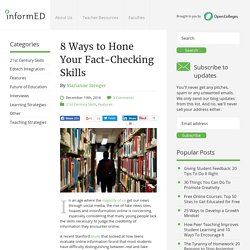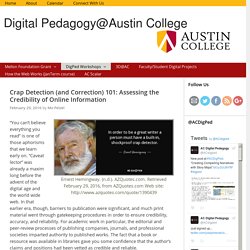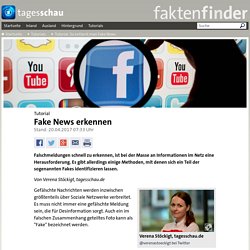

Choosing the best sources: 5 approaches (Crap Detection) - Uni Toronto. 8 Ways to Hone Your Fact-Checking Skills - InformED. In an age where the majority of us get our news through social media, the rise of fake news sites, hoaxes and misinformation online is concerning, especially considering that many young people lack the skills necessary to judge the credibility of information they encounter online.

A recent Stanford study that looked at how teens evaluate online information found that most students have difficulty distinguishing between real and fake news. Of the 7,804 middle-schoolers who were surveyed, 82% were unable to tell an ad marked as “sponsored content” apart from a real news story, and many said they judged the credibility of news based on how much detail was given or whether a large photo had been included, rather than on the source. Clearly, many of us need a better understanding of how to evaluate the information we come across online, and the first step is realising just how easily fake news and misinformation can spread. Learn to Assess the Credibility of Your Sources 1. 2. 3. 4. 5.
San Antonio, Texas Local Community News & Journalism. At NOWCastSA, we try to make the world a better and more sensical place by empowering people to separate facts from crap - to distinguish the real and the true from the misinformation, disinformation and sometimes deliberately deceptive information circulating online.

This is a toolbox for the good Netizens - citizens of the Internet - who are concerned with testing the accuracy and credibility of online information and helping float the good stuff and sink the crap. The right tools make it easy. As the writer, artist and online instigator Howard Rhiengold said in his seminal Crap Detection 101, “The hard part, as always, is the exercise of flabby think-for-yourself muscles.” Thanks to Rheingold and others who have curated and shared resources over the years, here are some questions to ask and tools you can use to check the credibility of online information. Who is the author? If it is a news site, does it clearly disclose ts funding sources? Howard Rheingold: Crap Detection Mini-Course. Crap Detection 101: Assessing the Credibility of Online Information.
“You can’t believe everything you read” is one of those aphorisms that we learn early on.

“Caveat lector” was already a maxim long before the advent of the digital age and the world wide web. In that earlier era, though, barriers to publication were significant, and much print material went through gatekeeping procedures in order to ensure credibility, accuracy, and reliability. For academic work in particular, the editorial and peer-review processes of publishing companies, journals, and professional societies imparted authority to published works. The fact that a book or resource was available in libraries gave you some confidence that the author’s claims and positions had been vetted as credible and reliable.
Today, peer-review and editorial oversight remain important. Technologist Howard Rheingold has argued that “crap detection” is one of the core literacies we need to cultivate. Clarifying in our mind exactly what we are searching for. Who is the author of this information? Tutorial: Fake News erkennen. Falschmeldungen schnell zu erkennen, ist bei der Masse an Informationen im Netz eine Herausforderung.

Es gibt allerdings einige Methoden, mit denen sich ein Teil der sogenannten Fakes identifizieren lassen. Von Verena Stöckigt, tagesschau.de Verena Stöckigt, tagesschau.de Gefälschte Nachrichten werden inzwischen größtenteils über Soziale Netzwerke verbreitet. Es muss nicht immer eine gefälschte Meldung sein, die für Desinformation sorgt. Absender kontrollieren Bevor man ein Posting teilt, sollte man sich das Profil des Absenders genau ansehen.
Fotos und Videos überprüfen Generell ist es ratsam, sich Fotos im Netz genau anzusehen. Mit der umgekehrten Bildersuche lassen sich viele gefälschte Inhalte und im falschen Zusammenhang geteilte Inhalte entlarven. Liegen mehrere Kopien eines Videos vor, kann der YouTube-Dataviewer von Amnesty International beim Finden der Originalversion helfen. Diese kann man anschließend durch eine integrierte umgekehrte Bildersuche laufen lassen. Impressum ansehen. Network Literacy Part One (Howard Rheingold) Network Literacy Part Two (Howard Rheingold) Attention, and Other 21st-Century Social Media Literacies. © 2010 Howard Rheingold.

The text of this article is licensed under the Creative Commons Attribution NonCommercial License ( EDUCAUSE Review, vol. 45, no. 5 (September/October 2010): 14–24 Howard Rheingold (howard@rheingold.com) is the author of Tools For Thought, The Virtual Community, Smart Mobs, and other books and is currently lecturer at the University of California, Berkeley, and Stanford University. Comments on this article can be posted to the web via the link at the bottom of this page. If you were the only person on earth who knew how to use a fishing rod, you would be tremendously empowered. Social media—networked digital media such as Facebook, Twitter, blogs, and wikis—enable people to socialize, organize, learn, play, and engage in commerce.
I focus on five social media literacies: Attention Participation Collaboration Network awareness Critical consumption Attention Attention is also important in the classroom. Participation Collaboration Network Awareness How do we do that? Notes.